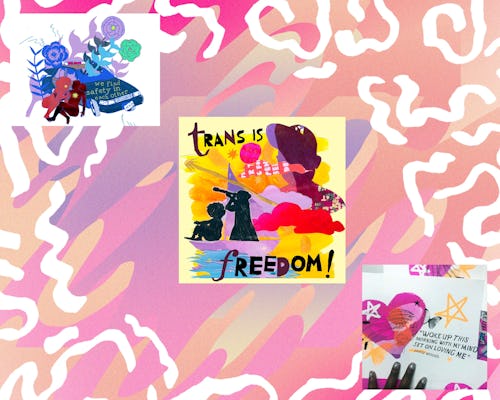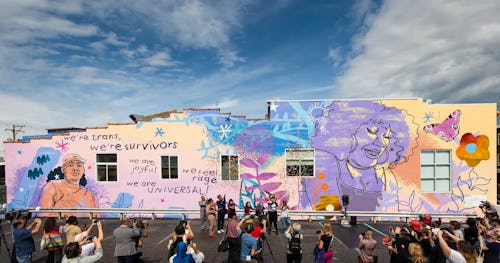
Our Streets is a column by writer and reporter Ray Levy Uyeda that highlights activists, artists, and organizers who are doing the work and reclaiming power for the people.
One of the tasks of movement workers is to help us imagine what a more humane world could look like. The social ideologies that govern our lives can seem so deeply entrenched; systems of capitalism and production or justified poverty can seem inherent to life on Earth. But the reality is that we can correct for inequities like poverty, a lack of access to food or education, or environmental injustices born out of redlining — if we can imagine new ways of living.
It’s artists who help us envision most literally the alternate possibilities of relating to one another, understanding ourselves, and building a future that values differences rather than tries to smooth them over. With their murals, illustrations, and graphic designs, people become inspired and messages become concretized. Art catalyzes movements; art is the blood of change.
What sets movement art aside from other forms of art is that the message, whether it’s political, personal, or interpersonal, is baked into the work. It’s not necessarily art that motivates you toward a particular candidate, rather it’s art that pushes you toward a new way of thinking and living. Artists who create this work want to communicate something specific, either by including text in the image, like “vote to make your voice heard” or “trans is beautiful,” or by portraying the face or work of a well-known activist or organizer, like Angela Davis, with whom a political message is associated.
The San Francisco-based graphic artist Broobs tells Mic that the movement is as much about protesting injustices and organizing for change as it is about taking time for rest and “reminding each other of what we're fighting for.” Their collage work often features a central figure, like James Baldwin or Barbara Gittings, backgrounded by imagery of plants or other arboreal shapes. In some ways, their pictures remind us that we’re continuing the fights against the same threads of racism and homophobia that Baldwin and Gittings battled. They also help us remember that marginalized people have survived, and will survive, multiple manifestations of harm. Broobs’s art strives to help people feel hopeful and less alone, which is important, because movements against anti-trans violence, homophobia, and racism are won together.
Broobs began posting their collages in 2014, but the work really took off in 2020, when people looked to Instagram for portrayals of marginalized people that highlighted their beauty and humanity, in the midst of so much violence against them. The posts began with images of queer figures or Black revolutionaries in history. “Learning what came before helps me understand where we're at now and where we might … go,” Broobs says.
For Kah Yangni, a painter, illustrator, and muralist based in Philadelphia, “so much art is aspirational. It’s not what is, it’s what you wish would be.” Yangni, who has painted murals supporting voting rights and advocating for young people to vote, uses pastel hues of purple, pink, and blue in nearly all of their work, colors that they believe are calming and contrast the hyperactive and violent conditions of many people’s everyday lives.
Art is collaborative for Yangni. In a mural they painted on the building of a local woman- and trans-owned bakery called Cake Life Bake Shop, located in Philly’s Fishtown neighborhood, the text overlaid on the painting comes directly from a workshop Yangni conducted with residents at Morris Home, a group home for trans people located in West Philadelphia. The workshop attendees told Yangni that they wanted the mural, which is called We Are Universal, to say, “We’re trans, we’re survivors. We’re joyful. We feel rage. We are universal.” So that’s what Yangni painted, along with portraits of two people and pastel illustrations of flowers, leaves, and butterflies.

Like Yangni, Broobs also creates art that seeks to move people to take action. Their art has to raised money for trans asylum seekers and migrants in the Bay Area and shined light on the work of grassroots organizations like Moms 4 Housing, a collective of homeless and marginally housed mothers. “I'm just trying my best with what I have in my … skill set to do what I can to make the world I just want to live in,” Broobs says. “And I have seen from art history that revolutions are often won with art.”
Indeed, Yangni says, there needs to be space for people to be mad about how they’re being treated and push back against people in power. Trans rights are under attack across the country, with statehouses passing legislation to prevent trans people from receiving health care and intimidate parents into rejecting the needs and wishes of their trans children. There is no substantive legislation at the state or federal level to tackle the epidemic of violence that Black and brown trans women face, and systemic problems of houselessness and joblessness persist.
“Trans people are mad about the situation,” Yangni tells Mic. With the Cake Life Bake Shop mural, they wanted to “make something that feels good to look at, but also not lie that we’re happy all the time.”
Pushing back against everyday acts of violence was also Tatyana Fazlalizadeh’s goal in her series of portraits called Stop Telling Women To Smile. The project attempts to answer the question: What would the world look like if women and girls felt safe every time they went outside?
The project started with Fazlalizadeh’s own experience. She’d been harassed by men on her way to work and school, or just while hanging out in her Brooklyn and Philadelphia neighborhoods. She decided to push back against the verbal violence — both the aggressors’, as well as the complicity of others who witnessed harassment but did not try to stop it, with a self-portrait that declared, “STOP TELLING WOMEN TO SMILE.”
Shortly after, the project expanded into a more community-based effort, in which Fazlalizadeh interviewed and sketched women, pairing their portraits with statements from their interviews, which inevitably were reflections of their own experiences of being harassed. Some portraits read, “I AM NOT AN OBJECT HERE FOR YOUR ADMIRATION,” while others speak to the feeling of unsafety that comes after being harassed. It’s now an international movement that tackles gender-based street harassment in the black and white portraits that are wheat pasted onto sides of public buildings.
It may seem like a small thing — to call a woman “baby” or “sweetie” as she walks by — to those who do it. It may even seem like a compliment. Fazlalizadeh says that’s because violence has “been so normalized that you don't see anything wrong with it.” In fact, she says, violence and harassment against women and girls has been the cultural norm in the U.S. for so long that pushing back on it in public can be confusing to some.
“Calling out the small moments … is what has been the confusion for most people,” Fazlalizadeh says. Most people generally don’t disagree when you say we should stop violence against women, she explains. But “when you start to get down to the nitty gritty of it, and you start to point out and say, No, [street harassment] is violence. This thing that maybe you have done in your life or that you have watched your friends do or you have watched your peers and your brothers and your family members do, that is violence” — that’s when people can get defensive, she says.
Even while she was working on the project, Fazlalizadeh says street harassment was taking a physical, mental, and emotional toll on her. Conversations with others about their experiences allowed her to find the language and courage to engage with those who committed everyday acts of violence against her. “I [felt] more powerful in myself for one, but I also felt particularly powerful in myself in my neighborhood,” she says.
Fazlalizadeh says that she started to interject when a comment became sexual or demeaning by telling the harasser how the remark made her feel unsafe, and that she wanted to be able to walk through her own neighborhood without fear. The conversations worked — not all the time, but often enough to where Fazlalizadeh felt that she could take some power back. It was the portraits that helped her get there.







